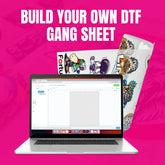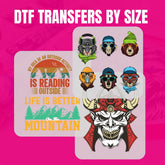What is DTF? Understanding the Latest Heat Transfer Technology
One of the most innovative and adaptable techniques in the custom printing sector is Direct-to-film printing, DTF. Whether you're an entrepreneur starting your own business or a DIY enthusiast looking for a more efficient way to create custom apparel, DTF provides a solution. The main characteristics of this heat transfer technology, DTF, will be discussed in this article, along with its working mechanisms. We will also discuss What is DTF, the tools and equipment you require, the benefits and drawbacks, and how it will affect the printing environment. Let's dissect it so that everyone can grasp it easily.
What is DTF?
DTF printing is a procedure whereby designs are printed onto a specific film, then heated, pressurized, and transferred onto different materials. Offering a better degree of detail and color accuracy than conventional techniques, it creates vivid and lasting designs on fabrics using specialist printers, inks, and powders. Direct-to-film, or DTF for short, as the name implies, immediately prints drawings onto a film and then transfers them to cloth or another material.
DTF transfer sheets allow companies who require flexibility with more complex patterns free from color restrictions, unlike techniques like screen printing or heat transfer vinyl (HTV). It works on practically any material, including leather, cotton, polyester, and even tougher surfaces like cups or wood.
The DTF Printing Process: Step-by-Step
DTF printing's magic resides in its procedure, which consists of a few straightforward yet necessary actions. Whether you intend to start employing this technology for your company or deal with DTF transfer sheets, knowing the whole process is vital.
Create the Design
The procedure begins with your designing your artwork. Your artwork should be created in a high-resolution format (usually 300 dpi) and guaranteed to have a translucent backdrop. This guarantees that, upon transfer to cloth, the print quality is sharp and clear.
Printing onto PET Film
Following design readiness, a specialist DTF printer prints the pattern onto a PET (polyethylene terephthalate) film. These printers run CMYK (cyan, magenta, yellow, and black) inks; for designs calling for it, a white ink layer is also applied behind the color layer to improve vibrancy and opacity.
Applying Hot Melt Adhesive Powder
The film passes under a layer of hot melt adhesive powder following the print of the design. Crucially for the transfer's longevity, the powder follows the wet ink on the film.
Curing the Adhesive
The adhesive melts and cures in a heat tunnel or under a heat press, permanently binding the ink to the film. The end effect is a transfer film suitable for fabric application.
Heat Pressing onto Fabric
Placing the DTF transfer on the cloth and running the design across a heat press comes last. The heat press is adjusted to a specified temperature for ten to fifteen seconds—usually between 275°F and 295°F. The vivid, robust design on the cloth is revealed when the film is pulled away during pressing.
Key Features of DTF Printing Technology
After we have discussed what DTF is, let's investigate the main characteristics of DTF printing techniques that appeal so much to different custom printing requirements.
Versatility Across Materials
DTF printing stands out mostly for its capacity to operate on various materials. DTF transfers offer unparalleled adaptability from cotton t-shirts to polyester bags, leather coats, and even hard surfaces like mugs or wood. You can thus apply it to almost any product you wish to personalize.
Vibrant and Detailed Designs
High-resolution, vivid colors are a hallmark of DTF transfer sheets. DTF guarantees that the colors pop and the details are clear whether you print a basic logo or a sophisticated multi-colored design. This makes it a great choice for companies that demand exact designs incorporating complex logos or thorough artwork.
Durability and Flexibility
Applied once, DTF transfers are remarkably adaptable and robust. The graphics do not readily dissolve, peel, or fade even with several washes. Sportswear or custom hoodies are perfect for clothing that calls for great durability and comfort since the prints guarantee that they move with the fabric.
No Weeding Required
Unlike vinyl printing, DTF transfer sheets eliminate the need for weeding. Weeding is labor-intensive and time-consuming, as is the hand removal of extra vinyl surrounding a design. DTF speeds up and simplifies the procedure considerably.
Cost-effective for Small Runs
Small batch orders also call for DTF printing. DTF printing is cost-effective for companies handling custom orders or short runs since, unlike other techniques, it does not need costly setup expenses. DTF offers flexibility without a heavy price, whether you're printing simply a few shirts or a batch of customized iron on decals.
Equipment Needed for DTF Printing
Starting with DTF printing calls for certain basic tools and equipment. The payback in quality and adaptability is well worth the sometimes large expenditure.
DTF Printer
Direct printing onto PET film requires a specialist DTF printer. Many times, modified inkjet printers with CMYK inks and white ink can print high-quality designs.
DTF Inks
DTF inks are specifically developed to fit the DTF technique. These water-based colors produce vivid, long-lasting graphics that are resistant to heat transfer and cleaning.
Hot Melt Adhesive Powder
The DTF method depends critically on the adhesive powder. It guarantees the print stays whole upon transfer into cloth and hooks to the ink on the PET film.
Heat Press
Transferring the design from the film to the cloth requires a heat press. A reliable heat press guarantees perfect transfer with the correct temperature and pressure.
PET Film
Your design finds a canvas in the PET film. This strong, flexible material stores the ink and adhesive during printing and transfer operations.
The Advantages and Disadvantages of DTF Printing
DTF printing offers advantages and drawbacks, much like any printing technique. Knowing them will enable you to determine whether this technology is appropriate for your situation.
-
DTF Printing High-Quality Results: With brilliant, vivid colors and fine details, DTF presents extraordinary print quality.
-
No Need for Special Fabric: DTF operates on a broad spectrum of materials, unlike sublimation, which calls for particular fabrics.
-
Fast Production: DTF printing is a quick procedure once the equipment is set up, so it is perfect for rapid turn-around times.
-
Durability: Long-lasting prints of DTF transfers are well-known for not fading or cracking even after several washes.
Initial setup costs for DTF printing inks, a heat press, and a printer can be high. Though the technique is simple, there is a learning curve, particularly about heat press settings and ink mixing, to get things precisely right.
Conclusion
What is DTF? This innovative heat transfer method lets companies and enthusiasts produce vivid, robust, and high-quality graphics on various materials. Custom printing will find DTF printing a game-changer because of its adaptability, capacity to create complex designs, and long-lasting effects. For any custom printing company, the efficiency, scalability, and quality it provides are justified, even if there are some upfront expenses.
If you’re interested in starting your DTF journey or want to learn more about how DTF can enhance your business, check out DTF Transfer Art for high-quality DTF transfer sheets and printing supplies.
- bulk printing
- Custom clothing printing
- custom gangsheet
- decal transfer
- decal transfers
- Digital printing
- dtf transfer
- dtf transfer art
- dtf transfer film
- dtf transfer instructions
- dtf transfer paper
- dtf transfer printer
- dtf transfer sheets
- dtf transfers near me
- dtf transfers ready to press
- dtf transfers wholesale
- gangsheet printing
- heat transfer decals
- Printing companies
- Quality printing
- Transfer printing






